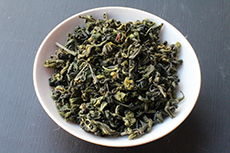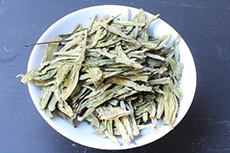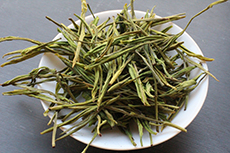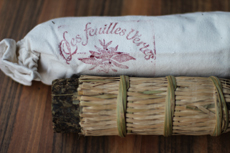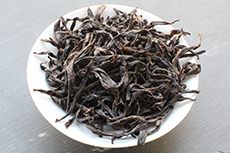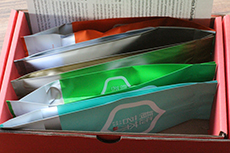.
Search results
Results 1 till 8 of a total of 8 (1 pages).
-
Xiao Ye Zhong
-
Shui Xian
-
Fo Xiang Bai Cha
Fo Xiang, Buddha Scent, is a very high quality tea produced in the form of Gunpowder or Chinese Zhu Cha, pearl tea. Just like An Ji Bai Cha it is produced with the leaves of the white leaved tea plant. A really beautiful example for the influence of the tea's form on its taste. Plucked by hand and produced by machine, however artisanally.The producer, who is known in his town as a tea freak, crazy for tea, owns vast tea gardens in the hills around Xinchang and produces a diversity of teas from diverse varietals in good quality.The tea is called Bai Cha, white tea, because the leaves are of a pale green, almost white, when they are plucked, as this tea plant has very little chlorophyll. However, it is produced in the manner of green tea. These tea plants with the whitish leaves had already been described during the Song-dynasty (960-1279), and were ever since thought to be a myth. At the end of the 20th century, however, a wild tea tree of this kind was (re-?)discovered. Teas from this tea varietal are very smooth and incredibly sweet in aroma. Because of the high degree of a certain amino acid in the tea plant these teas have a pronounced umami-taste. -
Bai Ya Long Jing
Baiya Longjing or Baicha Longjing has also been produced from a white-leafed tea plant; but it comes from Xinchang, and not Anxi. It is produced with leaves of the tea plant with the whitish leaves. Exceptional delicacy displaying aromas between An Ji Bai Cha and Long Jing Shi Feng. A beautiful example for the influence of the form on the taste.The producer, who is known in his town as a tea freak, as he is crazy for tea, owns vast tea gardens in the hills around Xinchang and produces a diversity of teas from diverse varietals in good quality.The tea is called Bai Cha, white tea, because the leaves are of a pale green, almost white, when they are plucked, as this tea plant has very little chlorophyll. However, it is produced in the manner of green tea. These tea plants with the whitish leaves had already been described during the Song-dynasty (960-1279), and were ever since thought to be a myth. At the end of the 20th century, however, a wild tea tree of this kind was (re-?)discovered. Teas from this tea varietal are very smooth and incredibly sweet in aroma. Because of the high degree of a certain amino acid in the tea plant these teas have a pronounced umami-taste. -
An Ji Bai Cha
A very famous rarity, which is currently considered one of the best green teas of China. An Ji Bai Cha is a needle-shaped tea (Zhengxingcha) that was roasted in a revolving drum or a shaking machine. This tea is produced by the family of the man who discovered the white-leaved tea bush and they keep the secret of one of the steps in the production (possibly a light rolling) between the roasting in the revolving drums and the shaping in the shaking machine.The tea is called Bai Cha, white tea, because the leaves are of a pale green, almost white, when plucked, resulting from a very small quantity of chlorophyll in the leaf. However, it is produced in the manner of green tea. These tea plants with the whitish leaves had already been described during the Song-dynasty (960-1279), and were thought to be a myth ever since. At the end of the 20th century, however, a wild tea tree of this kind was (re-?)discovered. Teas from this tea varietal are very smooth and incredibly sweet in aroma. Because of the high degree of a certain amino acid in the tea plant these teas have a pronounced umami-taste. -
Shui Xian Shi Liang Cha 2014
This Heicha is made from Shuixian teaplants from Fenghuang; it can thus be considered a Phoenix Heicha. Harvested in the spring of 2013 from the tea varietal Shui Xian Bai Ye in Fenghuang as well as the neighbouring district, Raoping. The tea has then been crafted into a Heicha in Anhua, in Hunan province. It is in Anhua province that the traditional Heicha Qianliangcha and Fuzhuancha are produced. -
Mi Lan Xiang
A good and typical Fenghuang Dancong, traditionally produced and moderately roasted above charcoal from litchi-wood. The leaves come from bushes of the Baiye sub-varietal (White leaf) from Danhu at Wudong Mountain. The better quality from the Baiye are called Milanxiang, which means scent of honey-orchids and indicate a honey-sweetness in the tea. -
Grüntee Varianten Xinchang
Five special teas from the same producer, two of them from overgrown tall tea plants, two hand-processed and lightly roasted over charcoal. Two of the five teas have been in Länggass-Tee's range for some time, the last three are exclusively in this set. Pan, a producer who is considered as a tea maniac in his town, has extensive tea gardens in the hills around Xinchang and produces various teas from a wide range of tea plant varieties of exceptional quality. He also produces green teas from other tea gardens in Zhejiang province, and more recently from old tea bushes in overgrown tea gardens.In addition to the origin and variety of the tea plant, the shape also plays a major role in the taste of a tea. Throughout China, different green tea processing methods exist, which can be divided into categories according to shape.This set now unites different processing forms of Chinese green teas: Maojian and Maofeng as spirally curved teas, a flat-form tea and two pearl teas from two different tea plant varieties.Contents: 25g Jin Jiang Hui Ming, 25g Fo Xiang Bai Cha, 25g Tan Bei Yun Wu, 25g Ye Sheng Mao Feng, 25g Ye Sheng Long Jing.
.






